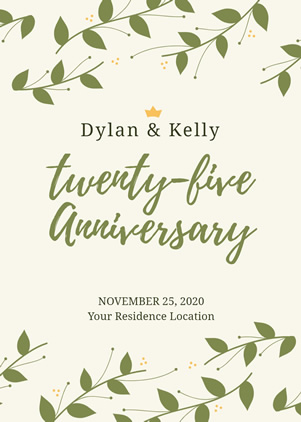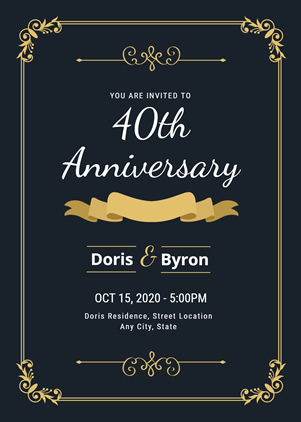...
Categories
Chart
Bar
Pie
Table
Sitemap
Swot Analysis
Area
Flowchart
Line
Map
Column
Organizational
Venn Diagram
Card
Wedding
Baby
Easter
Anniversary
Graduation
Greeting
Congratulations
Thank You
Valentines Day
Birthday
Halloween
Mothers Day
Thanksgiving
Fathers Day
Invitation
Business
New Year
Christmas
Halloween
Fathers Day
Baby Shower
Christening
Mothers Day
Thanksgiving
Engagement
Graduation
Party
Easter
Anniversary
Poster
Birthday
Music
Travel
Movie
Animal & Pet
Party
Motivational
Environmental Protection
Industrial
Fashion & Beauty
Kids
Non-profit
Exhibition
Law & Politics
Art & Entertainment
Sale
Holiday & Event
Business
Coronavirus
Sports & Fitness
Search: {{local.search_error_key}}
Search: {{local.search_subcategory}} in {{local.search_category}}
Sorry, no matches found. Please try again with different words or browse through our most popular templates.

Preview
Customize
25th Anniversary Invitation

Preview
Customize
Beautiful 40th Anniversary

Preview
Customize
Beautiful Wedding Invitation

Preview
Customize
Happy Tea Party

Preview
Customize
Golden Mortarboard Graduation

Preview
Customize
Elegant Mothers Day Invitation

Preview
Customize
Party Christmas Invitation

Preview
Customize
Colorful 1st Birthday

Preview
Customize
Warm Christmas Invitation

Preview
Customize
Floral Birthday Invitation

Preview
Customize
Elegant Engagement Party

Preview
Customize
Beautiful Wedding Invitation

Preview
Customize
50th Anniversary Party

Preview
Customize
Cartoon Housewarming Invitation

Preview
Customize
Cheerful New Year Invitation

Preview
Customize
Ring Wedding Invitation

Preview
Customize
Sweet Wedding Invitation

Preview
Customize
New Year Party Invitation

Preview
Customize
Creative Wedding Invitation

Preview
Customize
Creative Wedding Invitation

Preview
Customize
Leaf Wedding Invitation

Preview
Customize
Save the Date Invitation

Preview
Customize
Wedding Bridal Shower

Preview
Customize
Graceful Wedding Invitation

Preview
Customize
10th Anniversary Invitation

Preview
Customize
Wedding Save the Date

Preview
Customize
Christmas Costume Party

Preview
Customize
Decoration Christmas Party

Preview
Customize
Flower Wedding Invitation

Preview
Customize
Graduation Prom Invitation

Preview
Customize
Colorful New Year Invitation

Preview
Customize
Cute Birthday Invitation

Preview
Customize
Creative Wedding Invitation

Preview
Customize
Unique Baby Shower Invitation

Preview
Customize
Save the Date Invitation

Preview
Customize
Graceful Engagement Invitation

Preview
Customize
Bachelorette Party Invitation

Preview
Customize
Grand Chinese New Year

Preview
Customize
40th Birthday Invitation

Preview
Customize
Cartoon Baby Shower

Preview
Customize
Simple Engagement Invitation

Preview
Customize
Mothers Day Celebration

Preview
Customize
Company Anniversary Invitation

Preview
Customize
Attractive Quinceanera Invitation

Preview
Customize
Year End Party Invitation

Preview
Customize
60th Birthday Invitation

Preview
Customize
Floral Baptism Invitation

Preview
Customize
40th Anniversary Invitation
Cancel
Customize
